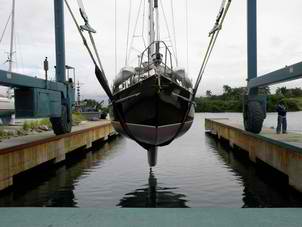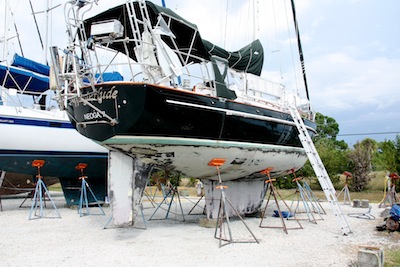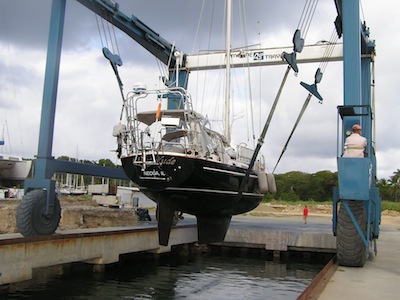We’ll have to haul out again this spring … seems like we just did this. Unfortunately our haul-outs are rarely quick. But this spring, we intend to finally take the time and get it right so we don’t have such a hassle with bottom prep every time before new bottom paint! Here’s a quick haul out checklist.

Pre-Haulout
Empty Tanks. Empty the holding tank & water tanks to lessen the load if there’s any question about the lift tonnage or ability to safely lift the boat.
Safe Vessel Lift Points. Ideally know where your vessels safe lift points are located – some manufacturers mark them on the hull. If you have no idea, try to locate the straps at bulkhead locations as they are typically stronger than the rest of the structure.
Instrumentation. Make sure you know where your speedometer & depth sounder and any instrumentation on the exterior of the hull so the straps don’t accidentally bust them
Don’t Get The Shaft! Know where your propeller shaft comes out so the yard doesn’t accidentally put the back strap against the shaft — nothing good can happen!
Travel Lift Strap Damage. The straps are going to come up on the sides of the boat, make sure there’s nothing in the way — such as our kayaks, or folding solar panels. Also make sure the straps won’t damage rub rails.

Haul Out
Pressure Wash: Once the boat is hauled out of the water, have the hull pressure washed to remove all barnacles and slime.
Inspection: Look over your hull over for cracks or blisters. Check the condition of exterior through hulls, depth sounders and anything else located exterior on the hull.
Blocking the Boat. You are ultimately responsible for the yard safely blocking your boat. Most boats should be blocked under the keel and those blocks should carry the load. In most cases jack stands are meant to steady the boat holding it upright, not to carry the bulk of the weight.
Jack Stand Placement. Jack stands should be placed so that there’s at least one for every 10 feet or so on deck. Typically when we’ve been hauled, we’ve had 4 jack stands per side and we’re 37 feet.

Hauled Out Checklist
To Do List: Make your list of out of the water repairs and ideally get parts ordered for known repairs ahead of time so you’re not wasting time waiting on parts while you’re hauled out & living on the hard (yuck!)
Check Engines, Props, Shafts: Replace worn cutlass bearings and shaft and stuffing box packing. Inspect propellers and plan to sand and paint. Check propeller pitch and balance.
Through-hulls: Check for corroded fittings. Test and lubricate all seacocks.
Transducers: Clean and lubricate to make sure paddle wheels for a speedometer rotates freely.
Zincs and Ground Plates: Replace all corroded zincs and inspect and clean ground plates (like our Dyna Plate for the SSB ground)
Anchors and chain: Inspect your anchors and chain and put new depth markers on if necessary. Remember, your ground tackle is only as good as it’s weakest link!
Bottom Prep: Sand and prep the bottom for new bottom paint. Be sure to follow the paint manufacturers prep instructions – these are often more critical to how the paint performs than the actual paint job.
Paint: Use at least 2 coats of your preferred anti-fouling paint. Add an additional 2 coats on the bow front edge and the waterline. If you’re not doing the paint yourself, make SURE they don’t paint any paddlewheels or sensors into the hull so they cannot be removed as designed. Yes, we had this happen too.
****** MOST IMPORTANT***** Make SURE whoever’s doing the painting recognizes the fact that the jackstands will need to be moved and painted under, PAINT NEEDS TO DRY FOR MORE THAN A FEW HOURS, before the boat goes in the slings.
Often, the painter will shorten the process, waiting until the boat is in the slings to paint where the jack stands were, and only a short drying time is allowed before splash. And don’t forget the paint on the bottom of the keel where the boat was blocked – this can’t happen until the boat is in the slings.
Even worse is if you have someone else do the paint and they don’t finish until a day before the boat is scheduled to be launched. The paint doesn’t have time to cure. The last two times our boat has been painted and launched, the paint beneath the launch straps has not been set and as a result, we can tell exactly where the straps were because of the growth on the bottom paint. Grumble!
Ideally arrange to be the first boat in the following morning and ask if the boat can hang in the slings overnight – this allows more time for the paint on the bottom of the keel to harden.
NOTE: If you’re planning to stay aboard on the hard, be sure to read the Tips for Living Aboard in a Boatyard post here.

Launch Checklist
Launch Doublecheck: When the boat’s in the water, but before it’s out of the slings, make sure the engine starts and there are no bilge (or other) leaks. We had to be lifted back up one time because the stuffing box was repacked and not tightened – hence a voluminous flow of water into the boat! YIKES!
Don’t miss the post “Splash! 5 Tips from on the Hard to in the Water”, click here.
Once it’s done, it’s always a relief. Good luck and remember the end (more cruising joy) will justify the hassle.
Anyone have other items to add to the checklist? Please leave a comment and share! Cheers! Jan














[…] good friends at Commuter Cruiser would have JUST WHAT WE NEEDED! Jan and David have put together a very helpful checklist of all the things we need to remember to do BEFORE, DURING and AFTER our time on the hard. The […]
We hauled out in a cradle on rails, not a travel lift, but the essentials are the same- the is a great checklist.
I’d one note. Be sure to protect instruments from pressure washing, too: pull that transducer before they start! You don’t want it squashed by the slings, but you definitely don’t want it killed by high pressure water either. The boat next to us in the shipyard right now forgot, and they’ve just ordered a new one.
Thanks Behan! I’m following your haul-out on sailingtotem.com. I’m blindly jealous of ripping out your entire refrigeration and starting over! Cheers! Jan
I just inherited my grandpa’s vessel and so I am trying to research everything that I need to know so that I am ready to sail this summer. I know that I am going to have to have the boat placed in the water when I use it and so I am glad to know how the process will be like when it needs to be hauled out. I had no idea that the boat would need to have blocks, but it makes a lot of sense as I wouldn’t want the hull to carry the bulk of the weight. Once the boat has been properly hauled out and set on blocks, would it be safe to climb up into the boat?
Hi Faylinn! It should be safe to climb a ladder up to the boat while it’s on the hard if it’s blocked correctly. We always do. Check with the boatyard. Cheers! Jan